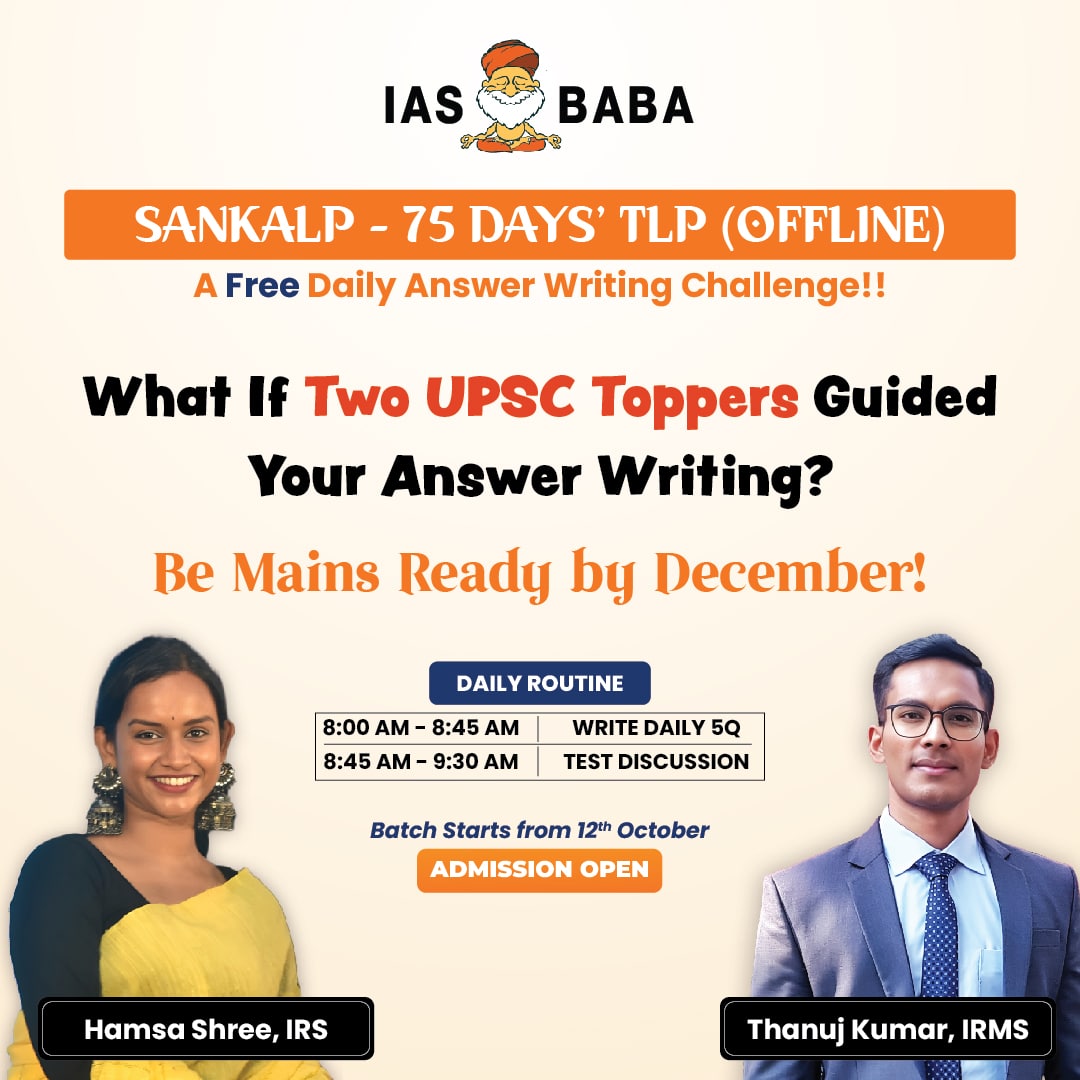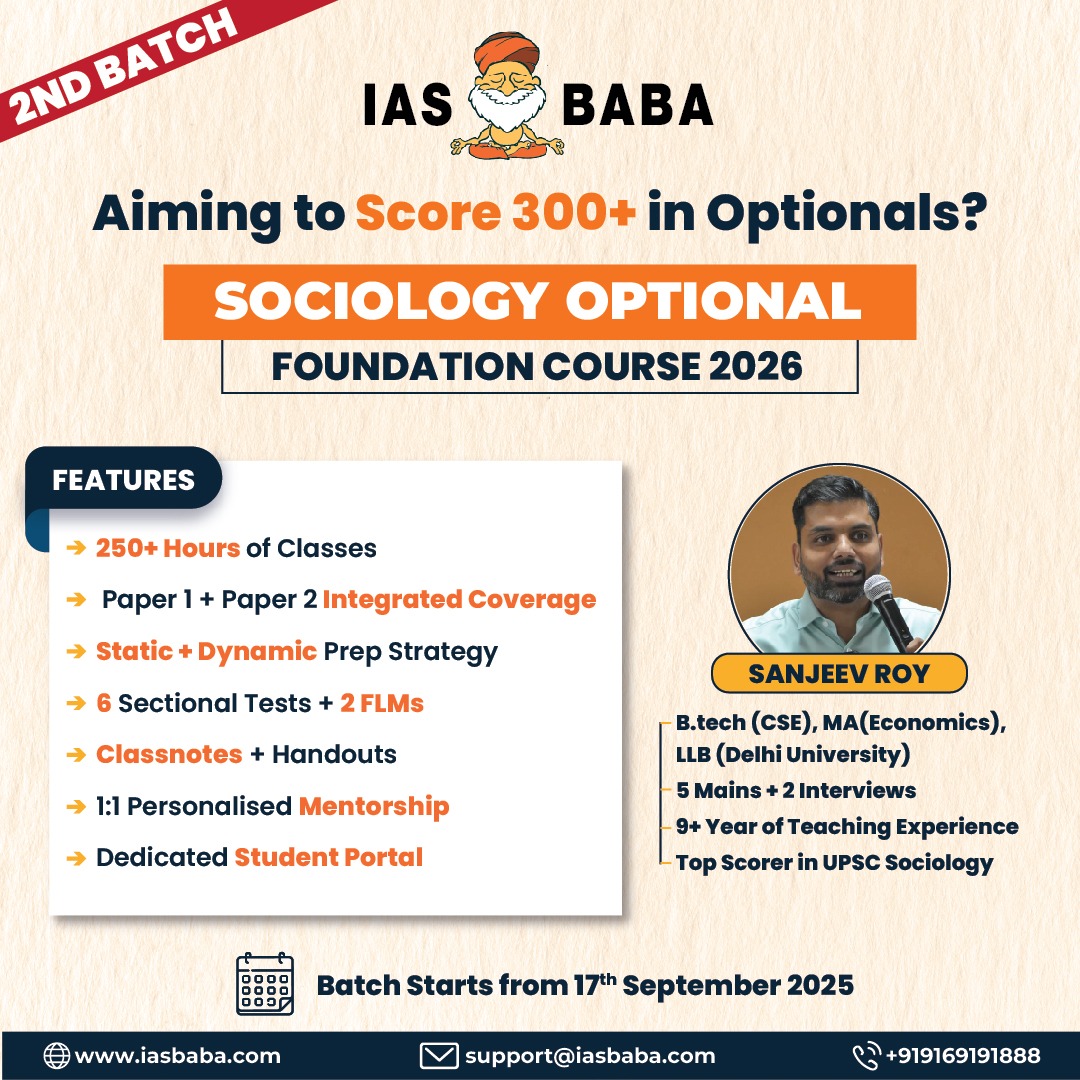IASbaba Daily Prelims Quiz
For Previous Daily Quiz (ARCHIVES) – CLICK HERE
The Current Affairs questions are based on sources like ‘The Hindu’, ‘Indian Express’ and ‘PIB’, which are very important sources for UPSC Prelims Exam. The questions are focused on both the concepts and facts. The topics covered here are generally different from what is being covered under ‘Daily Current Affairs/Daily News Analysis (DNA) and Daily Static Quiz’ to avoid duplication. The questions would be published from Monday to Saturday before 2 PM. One should not spend more than 10 minutes on this initiative.
Gear up and Make the Best Use of this initiative.
Do remember that, “the difference between Ordinary and EXTRA-Ordinary is PRACTICE!!”
Important Note:
- Don’t forget to post your marks in the comment section. Also, let us know if you enjoyed today’s test 🙂
- After completing the 5 questions, click on ‘View Questions’ to check your score, time taken, and solutions.
Test-summary
0 of 5 questions completed
Questions:
- 1
- 2
- 3
- 4
- 5
Information
To view Solutions, follow these instructions:
- Click on – ‘Start Test’ button
- Solve Questions
- Click on ‘Test Summary’ button
- Click on ‘Finish Test’ button
- Now click on ‘View Questions’ button – here you will see solutions and links.
You have already completed the test before. Hence you can not start it again.
Test is loading...
You must sign in or sign up to start the test.
You have to finish following test, to start this test:
Results
0 of 5 questions answered correctly
Your time:
Time has elapsed
You have scored 0 points out of 0 points, (0)
| Average score |
|
| Your score |
|
Categories
- Not categorized 0%
| Pos. | Name | Entered on | Points | Result |
|---|---|---|---|---|
| Table is loading | ||||
| No data available | ||||
- 1
- 2
- 3
- 4
- 5
- Answered
- Review
-
Question 1 of 5
1. Question
-
Japanese Encephalitis Virus (JEV), recently in news, is primarily transmitted to humans through the bite of which mosquito genus?
Correct
-
Solution: (c)
Explanation:
- Japanese Encephalitis Virus (JEV) is a mosquito-borne flavivirus.
- The primary vector is mosquitoes of the Culex genus, especially Culex tritaeniorhynchus.
- These mosquitoes breed in rice paddies and stagnant water in rural and semi-urban areas.
- Transmission cycle:
- Amplifying hosts: Pigs and wading birds, where the virus multiplies.
- Humans: Accidental or dead-end hosts, meaning humans do not contribute significantly to further transmission.
- Other mosquito genera:
- Anopheles – primarily malaria vectors.
- Aedes – vectors for dengue, chikungunya, Zika.
- Mansonia – vectors for filariasis.
- Key takeaway: Culex mosquitoes act as the bridge for JEV from animals to humans, making them the primary target for vector control measures.
Incorrect
-
Solution: (c)
Explanation:
- Japanese Encephalitis Virus (JEV) is a mosquito-borne flavivirus.
- The primary vector is mosquitoes of the Culex genus, especially Culex tritaeniorhynchus.
- These mosquitoes breed in rice paddies and stagnant water in rural and semi-urban areas.
- Transmission cycle:
- Amplifying hosts: Pigs and wading birds, where the virus multiplies.
- Humans: Accidental or dead-end hosts, meaning humans do not contribute significantly to further transmission.
- Other mosquito genera:
- Anopheles – primarily malaria vectors.
- Aedes – vectors for dengue, chikungunya, Zika.
- Mansonia – vectors for filariasis.
- Key takeaway: Culex mosquitoes act as the bridge for JEV from animals to humans, making them the primary target for vector control measures.
-
-
Question 2 of 5
2. Question
-
Match the following events (1919–1925) with their corresponding years:
List I (Event) List II (Year) 1. Jallianwala Bagh Massacre A. 1920 2. Nagpur Session of Congress (Non-Cooperation) B. 1919 3. Malabar Rebellion C. 1925 4. Swaraj Party formation D. 1921 5. Kakori Conspiracy E. 1923 Correct
-
Solution: (a)
- Jallianwala Bagh Massacre –
Date: 13 April 1919 (Amritsar, Punjab, Baisakhi day).
Confirmed: 1919 - Nagpur Session of Congress –
Date: December 1920 (Nagpur session of INC, adoption of Non-Cooperation Movement under Gandhi’s leadership, reorganization of Congress on linguistic basis).
Confirmed: 1920 - Malabar Rebellion (Moplah Rebellion) –
Duration: August 1921 – February 1922, in Malabar (present-day Kerala). It coincided with the Khilafat and Non-Cooperation movements.
Confirmed: 1921 (started in 1921, peak activity in that year). - Swaraj Party formation –
Year: January 1923, formed by C.R. Das and Motilal Nehru after Gandhi suspended Non-Cooperation.
Confirmed: 1923
Kakori Conspiracy (Train Robbery) –
Date: 9 August 1925, by Hindustan Republican Association (HRA) revolutionaries including Ram Prasad Bismil, Ashfaqulla Khan, Rajendra Lahiri.
Confirmed: 1925Incorrect
-
Solution: (a)
- Jallianwala Bagh Massacre –
Date: 13 April 1919 (Amritsar, Punjab, Baisakhi day).
Confirmed: 1919 - Nagpur Session of Congress –
Date: December 1920 (Nagpur session of INC, adoption of Non-Cooperation Movement under Gandhi’s leadership, reorganization of Congress on linguistic basis).
Confirmed: 1920 - Malabar Rebellion (Moplah Rebellion) –
Duration: August 1921 – February 1922, in Malabar (present-day Kerala). It coincided with the Khilafat and Non-Cooperation movements.
Confirmed: 1921 (started in 1921, peak activity in that year). - Swaraj Party formation –
Year: January 1923, formed by C.R. Das and Motilal Nehru after Gandhi suspended Non-Cooperation.
Confirmed: 1923
Kakori Conspiracy (Train Robbery) –
Date: 9 August 1925, by Hindustan Republican Association (HRA) revolutionaries including Ram Prasad Bismil, Ashfaqulla Khan, Rajendra Lahiri.
Confirmed: 1925 -
-
Question 3 of 5
3. Question
-
Consider the following statements regarding the recent US Federal Reserve interest rate cut and its possible impact on India:
-
A rate cut in the US can lead to higher Foreign Institutional Investment (FII) inflows into India, as investors seek better returns in emerging markets.
-
Increased capital inflows may strengthen the Indian Rupee against the US Dollar in the short run.
-
A stronger rupee can help ease imported inflationary pressures in India.
How many of the above statements are correct?
Correct
-
Solution: (c)
Explanation:
- Statement 1: Lower US yields push FIIs/FDIs towards India. This statement is Correct
- Statement 2: More inflows → higher rupee demand → appreciation. This statement is Correct
- Statement 3: Stronger rupee makes imports (like crude oil) cheaper, lowering inflation. This statement is Correct
Detailed Explanation with Example
- Impact on FII/FDI (Statement 1):
- When the US Federal Reserve cuts interest rates, returns on US bonds and deposits fall.
- Investors look for higher returns in emerging markets like India.
- Example: After the Fed’s rate cuts in 2008–09 (Global Financial Crisis) and 2020 (COVID-19 pandemic), India saw large FII inflows into equity and debt markets. This raised liquidity and boosted stock indices like the NIFTY and Sensex.
- Impact on Rupee value (Statement 2):
- With more dollars coming into India through FII and sometimes FDI, the demand for the rupee increases.
- Example: In early 2021, during the Fed’s accommodative stance, the rupee appreciated against the dollar as FIIs pumped billions into Indian equities.
- Hence, a rate cut strengthens the rupee in the short run.
- Impact on Inflation in India (Statement 3):
- A stronger rupee makes imports cheaper, especially critical imports like crude oil, edible oils, and electronic goods.
- Since India imports ~85% of its crude, even a ₹1 appreciation against the dollar can significantly lower the import bill.
Incorrect
-
Solution: (c)
Explanation:
- Statement 1: Lower US yields push FIIs/FDIs towards India. This statement is Correct
- Statement 2: More inflows → higher rupee demand → appreciation. This statement is Correct
- Statement 3: Stronger rupee makes imports (like crude oil) cheaper, lowering inflation. This statement is Correct
Detailed Explanation with Example
- Impact on FII/FDI (Statement 1):
- When the US Federal Reserve cuts interest rates, returns on US bonds and deposits fall.
- Investors look for higher returns in emerging markets like India.
- Example: After the Fed’s rate cuts in 2008–09 (Global Financial Crisis) and 2020 (COVID-19 pandemic), India saw large FII inflows into equity and debt markets. This raised liquidity and boosted stock indices like the NIFTY and Sensex.
- Impact on Rupee value (Statement 2):
- With more dollars coming into India through FII and sometimes FDI, the demand for the rupee increases.
- Example: In early 2021, during the Fed’s accommodative stance, the rupee appreciated against the dollar as FIIs pumped billions into Indian equities.
- Hence, a rate cut strengthens the rupee in the short run.
- Impact on Inflation in India (Statement 3):
- A stronger rupee makes imports cheaper, especially critical imports like crude oil, edible oils, and electronic goods.
- Since India imports ~85% of its crude, even a ₹1 appreciation against the dollar can significantly lower the import bill.
-
-
Question 4 of 5
4. Question
-
Consider the following statements regarding Radar technology:
-
Doppler radars are primarily used to detect the velocity of moving objects because they measure the change in frequency of reflected radio waves.
-
In phased array radars, the antenna is mechanically rotated to scan different directions, making them slower but more accurate than conventional radars.
Which of the above statements is/are incorrect?
Correct
-
Solution: (b)
Explanation:
- Statement 1: Doppler radars exploit the Doppler effect (frequency shift of radio waves due to motion) to measure velocity — widely used in weather monitoring, missile tracking, and traffic radars. This statement is Correct
Statement 2: Phased array radars do not rely on mechanical rotation; they use electronically steered beams to track multiple targets almost instantaneously, making them faster and more versatile than conventional rotating radars. This statement is Incorrect
Incorrect
-
Solution: (b)
Explanation:
- Statement 1: Doppler radars exploit the Doppler effect (frequency shift of radio waves due to motion) to measure velocity — widely used in weather monitoring, missile tracking, and traffic radars. This statement is Correct
Statement 2: Phased array radars do not rely on mechanical rotation; they use electronically steered beams to track multiple targets almost instantaneously, making them faster and more versatile than conventional rotating radars. This statement is Incorrect
-
-
Question 5 of 5
5. Question
-
Consider the following statements regarding Geothermal Energy:
Statement I: Geothermal energy can provide continuous baseload power unlike solar and wind.
Statement II: Geothermal reservoirs are independent of weather conditions and solar radiation.
Statement III: Geothermal power generation in India is already contributing significantly to the national grid.
Which one of the following is correct in respect of the above statements?
Correct
-
Solution: (c)
- Statement I: geothermal provides round-the-clock baseload power. This statement is Correct
- Statement II: geothermal heat is available regardless of weather or sunlight; hence it explains Statement I. This statement is Correct
Statement III: India has identified ~10 GW potential but geothermal power is not yet a significant contributor to the national grid (still in pilot stage). This statement is incorrect
Incorrect
-
Solution: (c)
- Statement I: geothermal provides round-the-clock baseload power. This statement is Correct
- Statement II: geothermal heat is available regardless of weather or sunlight; hence it explains Statement I. This statement is Correct
Statement III: India has identified ~10 GW potential but geothermal power is not yet a significant contributor to the national grid (still in pilot stage). This statement is incorrect
-
- Current Affairs Quiz, IAS Daily Current Affairs Quiz, IAS UPSC Current Affairs Quiz, IAS UPSC Prelims Quiz, IASbaba's Current Affairs Prelims Quiz, IASbaba's Daily Quiz, IASbaba's UPSC Quiz, Prelims Current Affairs Quiz, UPSC Current Affairs Quiz, UPSC Current Affairs Quiz IASbaba, UPSC Daily Current Affair Quiz, UPSC IAS Daily Quiz














